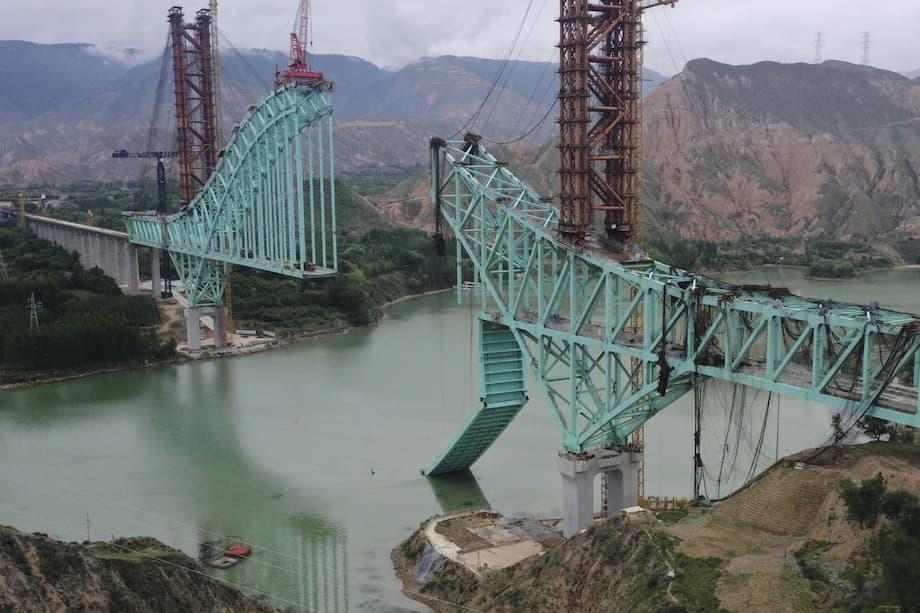Deadly Bridge Collapse in Qinghai: What Happened?
In the early hours of August 23, 2025, tragedy struck in northwest China when a section of a railway bridge under construction collapsed over the Yellow River in Qinghai province. The disaster claimed the lives of at least 12 workers and left four others missing, according to multiple official sources and international news outlets. The incident has prompted a massive rescue operation and a high-level government investigation, raising urgent questions about construction safety and oversight in one of China’s most ambitious infrastructure projects.
How Did the Collapse Occur?
The accident happened at approximately 3 a.m. local time during a critical phase of construction known as a “tensioning operation.” This process involves tightening steel cables to ensure the stability and alignment of large bridge sections. According to state media and eyewitness accounts, a steel cable suddenly snapped, causing a 108-meter (354-foot) steel girder arch rib to collapse. Sixteen workers were on the bridge at the time, with most of them thrown into the river below as the structure gave way.
Surveillance footage and video shared by local news outlets captured the dramatic moment: sparks flew from the bridge as the cable broke, and the central portion of the aquamarine arch plunged into the Yellow River, sending up a spray of water and debris. A resident living nearby described being jolted awake by a noise “like an earthquake.”
The Scale and Significance of the Bridge
The collapsed bridge was part of the Sichuan-Qinghai Railway, a major infrastructure project designed to connect the Tibetan Plateau with China’s high-speed rail network. The bridge itself was a feat of engineering: stretching 1.6 kilometers (about 1 mile) across the Yellow River, with its deck standing 55 meters (180 feet) above the water and its arch apex soaring to 130 meters (426 feet)—the height of a 40-story building. It was the first steel truss arch railway bridge to span the Yellow River, China’s second-longest river and a vital waterway for the region.
According to technical reports, the bridge’s cable towers weighed 1,800 tons each, and the maximum cable force on the side spans reached 1,161 metric tons—equivalent to the weight of 750 small cars. The project was nearing completion, with the main bridge originally scheduled to be joined by the end of August.
Rescue Efforts: Race Against Time
Immediately after the collapse, Chinese authorities launched a massive search and rescue operation. Over 800 personnel, including firefighters, police, and medical teams, were mobilized. The operation involved 91 vehicles, 27 boats, a helicopter, and five rescue robots, all working in challenging conditions to locate survivors and recover the missing.
Six hospitals in the region were placed on high alert, opening fast-track channels to treat any injured workers. Despite the scale of the response, hopes faded as hours passed without finding the missing workers. By Friday evening, the death toll had reached 12, with four still unaccounted for.
Eyewitness and Official Accounts
One local resident, who witnessed the aftermath, told reporters:
“I heard a huge noise in the middle of the night, like thunder or an earthquake. When I looked outside, I saw emergency lights everywhere and people rushing to the riverbank.”
Officials from the Ministry of Emergency Management and the State Council Work Safety Committee arrived on site to oversee the rescue and investigation. The government pledged to determine the cause of the accident as quickly as possible and to implement measures to prevent similar tragedies in the future.
Why Did the Bridge Collapse?
While the immediate cause of the collapse was the snapping of a steel cable during a tensioning operation, the broader reasons are still under investigation. The Ministry of Emergency Management and a special task force from the central government have been dispatched to Qinghai to lead the probe. The investigation will examine whether there were flaws in the bridge’s design, construction methods, materials, or safety protocols.
China’s State Council Work Safety Committee has made the investigation a top priority, with oversight from multiple agencies, including the National Railway Administration and the State-owned Assets Supervision and Administration Commission. The results of the probe are expected to be released in due course.
Engineering Challenges and Safety Risks
Building large-scale bridges over major rivers like the Yellow River involves significant engineering challenges. Tensioning steel cables is a delicate and dangerous process, as the forces involved are immense. Even a minor miscalculation or material defect can have catastrophic consequences. The installation precision of the cable towers and the quality of the steel cables are directly related to the safety and success of the entire structure.
Industrial accidents remain a concern in China, where rapid construction and ambitious infrastructure goals sometimes outpace safety regulations and oversight. In recent years, the country has experienced several deadly bridge and construction site accidents, prompting calls for stricter enforcement of safety standards.
China’s Infrastructure Boom and Its Risks
For decades, China has invested heavily in infrastructure, building railways, highways, airports, and bridges at a pace unmatched by most countries. The Sichuan-Qinghai Railway, of which the collapsed bridge was a key component, is part of a broader effort to integrate remote regions like the Tibetan Plateau into the national economy and transport network.
However, the pace of construction and the scale of projects have sometimes led to safety lapses. According to the New York Times, China has recently scaled back some infrastructure spending amid economic challenges, but the drive for rapid completion remains strong in many regions.
Recent Bridge Accidents in China
The Qinghai bridge collapse is not an isolated incident. Earlier in August 2025, a suspension bridge in Xinjiang snapped, causing five deaths and 24 injuries. In July 2024, a motorway bridge in Shaanxi province broke apart during heavy flooding, killing at least 11 people. These incidents highlight ongoing concerns about construction quality, maintenance, and the enforcement of safety standards.
Voices from the Scene and Beyond
As news of the Qinghai bridge collapse spread, condolences poured in from across China and around the world. The families of the victims have been offered support and counseling, while the government has promised a thorough investigation and accountability for any lapses.
In a statement, the Ministry of Emergency Management said:
“We are deeply saddened by the loss of life in this tragic accident. Our priority is to find the missing, support the families, and ensure that such incidents do not happen again.”
Construction workers and engineers across the country have expressed solidarity with their colleagues in Qinghai, calling for renewed attention to safety and training on high-risk projects.
What Happens Next?
The immediate focus remains on the search for the missing workers and the care of the victims’ families. The results of the official investigation will be closely watched, both in China and internationally, as they may have implications for future infrastructure projects and safety regulations.
Experts say that the tragedy should serve as a wake-up call for the construction industry and regulators. Improved oversight, better training, and stricter enforcement of safety standards are essential to prevent similar disasters in the future. The incident also raises questions about the balance between speed and safety in China’s ongoing infrastructure development.
In Summary
- A railway bridge under construction in Qinghai, China, collapsed on August 23, 2025, killing at least 12 workers and leaving four missing.
- The collapse occurred during a tensioning operation when a steel cable snapped, causing a 108-meter section to fall into the Yellow River.
- Over 800 rescuers, including boats, helicopters, and robots, were deployed in a massive search and rescue effort.
- The bridge was a key part of the Sichuan-Qinghai Railway and the first steel truss arch railway bridge to span the Yellow River.
- China’s State Council and Ministry of Emergency Management have launched a high-level investigation into the cause of the collapse.
- The tragedy highlights ongoing concerns about construction safety and oversight amid China’s rapid infrastructure expansion.
- Calls for improved safety standards and stricter enforcement have intensified in the wake of the disaster.




